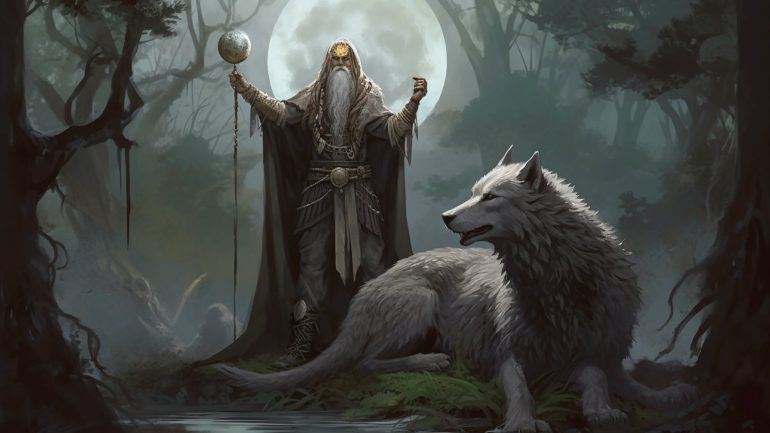This Druid Circle leans into the class’ ties to animals, empowering their Wild Shape to take to the battlefield as powerful beasts and, later on, forces of nature incarnate. They spend weeks at a time alone in the wilderness, not seeing another humanoid in that time, never mind another Druid. Rapidly shifting between their various animal forms, they patrol the land and chase off any monstrous trespassers.
In this Circle of the Moon Druid mini-guide, we’ll break down what this Circle provides you, as well as give you an insight on how to play this interesting subclass.
The Beasts Within: Circle of the Moon Features
Level Two
Combat Wild Shape – You can use Wild Shape as a bonus action, instead of an action. Also, whilst using Wild Shape, you can heal yourself as a bonus action by spending spell slots. You regain 1d8 hit points per spell level of the slot used. For example, a 2nd level slot would heal you by 2d8. Being able to shift into a beast form as a bonus action is what really makes Wild Shape reliable to use in combat, allowing you still to take the Attack action on the same turn. It should be noted that with the extreme duration of Wild Shape means that you don’t necessarily need to wait until the first round of combat to transform, but this makes it painless to shift if you get into combat you didn’t see coming.
Circle Forms – You ignore the ‘Max CR’ section of the Wild Shape table, instead you can change into a beast with a CR of 1 or lower. You must still abide by the other restrictions on the table, such as the no flying forms restriction, until you reach the listed level.
Once you reach 6th level, you can instead change into a beast with a CR equal to your Druid level divided by 3. For example, a 6th level Druid has a limit of CR 2. The meat of your subclass, this is what lets you become the infamous brown bear to tear those Tier 1s apart. The drastic increase in CR available to you makes you an absolute tank in combat whilst also able to deal out a respectable amount of damage. All whilst concentrating on any spells that take your fancy, which will benefit from the Constitution of your beast form.
Level Six
Primal Strike – The attacks of your best forms count as magical to overcome resistance and immunity to nonmagical damage. This is an important feature to keep your damage relevant, as resistance and immunity to nonmagical bludgeoning, piercing, and slashing become more common amongst monsters with higher levels. This isn’t flashy but comes at the same level you get an increase to Wild Shape’s max CR.
Level Ten
Elemental Wild Shape – Rather than a beast form, you can expend two uses of your Wild Shape simultaneously to instead transform into an air elemental, earth elemental, fire elemental, or water elemental. You choose from these specifically named forms, rather than being able to choose any monster with the elemental creature type. A needed boost to your combat forms at this point, with the earth elemental providing a very tanky option and the fire elemental providing you a significant damage output from Fire Form’s damage through movement.
Level Fourteen
Thousand Forms – You can cast Alter Self at will. At this level, this is mostly a thematic ribbon feature but does give you some resourceless utility in the social and exploration pillars. It should be noted that if you’re already concentrating on this spell when you Wild Shape, you can use the spell to enhance your forms, such as creating an aquatic cave bear.
Tips for playing a Moon Druid
Playing a Circle of the Moon Druid brings with it certain complications that you need to consider:
- Poor AC in beast form – This is a common issue among many beast forms you may be interested in, this is most easily remedied by straight Moon Druids by casting Barkskin before using Wild Shape. Otherwise, it is highly recommended you ask a party member to cast Mage Armor on you or gain a way to cast it on yourself.
- Difficulty communicating – Once you’re in your beast form, you’re going to have a hard time communicating effectively with your party members, given the long duration of Wild Shape, this can be an issue. The easiest way to resolve this at early levels is to choose a race with telepathy, alternatively, your party can assist you at different levels, such as a Soul Knife or the spell Rary’s Telepathic Bond, providing group telepathy.
- Keeping track of beast forms – It can be easy to fall into a pattern of always turning into a certain animal, but as you level, you must keep updating the beasts you choose to transform into, so you don’t fall behind in performance. An easy example of this is the brown bear you first get attached changing into should change into a Cave Bear when you hit 5th level. Besides linear power increases with forms, it’s also important to consider the benefits certain forms provide beyond damage and hit points, such as certain forms allowing you to restrain enemies when you hit them with an attack.
Recommended Beast Forms
- Brown Bear (CR 1) – Tanky for the level with good damage output and speed, the only downside here is the low AC.
- Giant Hyena (CR 1) – More hitpoints, higher AC, and faster than a brown bear, but with lower damage unless you’re lucky enough to finish off monsters regularly.
- Giant Spider (CR 1) – An interesting option that gives a controlling web attack, decent poison damage, great mobility, and blindsight.
- Cave Bear (CR 2) – A better version of a Brown Bear, this time with darkvision and a less dire AC.
- Giant Constrictor Snake (CR 2, Swim Speed) – The main appeal here is the Constrict attack, which auto restrains and grapples creatures with a good escape DC. This is a great choice to take on a control role whilst in beast form, giving advantage to your martial friends.
- Giant Elk (CR 2) – A high speed, 10 ft. reach, and the ability to add extra damage and knock creatures prone with Charge. This is a great skirmishing form against creatures with only a 5 ft. reach.
- Giant Scorpion (CR 3) – Three attacks, a decent amount of poison damage, and auto grappling claws are a great offensive option, with a good AC and a decent amount of Hit Points.
- Ankylosaurus (CR 3, Dinosaur) – This is a good choice for its proning attack if you got used to knocking monsters prone as a giant elk, this can do similar tactics but without needing to move 20 ft. first.
Countless Forms, Endless Fury – Sample Build
The Psionic Shapeshifter (Gem Dragonborn Moon Druid 20)
Here is a suggested Ability Score Array for this build using the point buy method, before applying racial ability score increases:
Str 8 Dex 14 Con 13 Int 12 Wis 15 Cha 10
Your racial ability score increase will raise your Constitution to 14 and your Wisdom to 17. The type of gem dragonborn you are is not important to the build, crystal is recommended for general use. The radiant type is not commonly resisted by monsters, but does shut down the regeneration of some creatures, if you anticipate a lot of enemy spellcasters, then Amethyst is recommended. Psionic Mind solves the issue of communicating whilst using Wild Shape, whilst also allowing you to communicate with creatures that don’t share one of your languages as a bonus. Gem Flight and the Breath Weapon features will both function whilst in a beast form, allowing you to become a flying, energy-breathing bear. This allows you to add even more mobility to your already mobile beast forms, as well as a different damage type and an AOE option, all without tying up your valuable concentration.
This build is about taking the typical expectations of a Moon Druid and giving it a twist, you’ll still take a ridiculous amount of hits whilst dealing moderate to good damage, but now you can step up against hordes and pursue flying enemies without the drawbacks of flying forms. You no longer have to compromise on hit points, damage, or wait until 8th level in order to fly, getting access to it much earlier at 5th level. Your concentration will be used for boosting your own AC and enhancing your beast forms in other ways. By taking Telekinetic at 4th level, you open up an at-will control option that synergizes perfectly with some of your control spells, particularly Spike Growth. It’s important to note that you won’t be able to use the Mage Hand whilst in a beast form, this is because until 18th level Wild Shape prevents you from casting spells regardless of components.
Key Levels
1-4: Your beast for this selection of levels will be a brown bear if you want a mix of tanking and damage, or a giant hyena if you would prefer to focus on tanking. Your concentration should be spent either on control spells like Entangle and Spike Growth, or Barkskin to increase your beast form’s AC. Your 4th level ASI should be spent on Telekinetic, which will raise your Wisdom to 18 and give you a bonus action shove that you can use whilst in your beast form. The Mage Hand adds utility to your Druid outside of combat, which is a nice bonus not normally available to a Druid.
5-10: As you gain access to CR 2 creatures, your brown bear should give way to a cave bear or giant elk, which opens up hit and run tactics should you wish to use them, and assuming that the monsters you’re fighting only have a 5 ft. reach. Your 8th level ASI can either be spent on increasing your Wisdom to 20 or taking Eldritch Adept to grab the Armor of Shadows invocation. This will give you the ability to cast Mage Armor at will, increasing the durability of a lot of your beast forms. At 10th level, you’ll gain access to elemental forms, allowing you to burn your Wild Shape uses faster for more interesting things to do in combat, however, be careful that you don’t use this too much and find yourself without a beast form when you need it most. Provided that you are fighting monsters that aren’t immune to fire, you can churn out a lot of damage using the fire elemental’s movement thanks to the Fire Form feature. From 7th level onwards, the Primal Beast version of the Guardian of Nature spell is a significant boost to your beasts, significantly increasing your damage.
11-15: As you head into Tier 3, you’ll gain access to CR 4 and CR 5 creatures, with the stegosaurus and brontosaurus being appealing if you have access to dinosaurs. The giant crocodile and giant shark are also good choices, with the latter being a bit niche, depending on water, unless you want to roleplay a magikarp. Your 12th level ASI can be spent on boosting your Wisdom, if you haven’t already maxed it, or picking up a feat that will help both of your forms, such as Alert, Lucky, or Sentinel. Once you gain Alter Self at will, you can start to participate in the social pillar a bit more by imitating others, as well as enhancing some beast forms with alternate forms of movement. This is a small bump for you but is worth noting as it can be helpful in certain circumstances.
16-20: The end of your career is a drastic shift in what you’ve gotten used to doing as an animal, and sometimes a violent incarnation of the elements. You’ll gain the ability to cast spells, ignoring the vocal and somatic components for your Druid spells, giving you access to a large amount of your spell list whilst in beast form. From this point on, you can also use your Mage Hand from the Telekinetic feat whilst in your beast form, greatly adding to the out-of-combat utility of forms without hands. Your capstone also brings you one of the most powerful features in 5E, unlimited Wild Shape uses that make you nigh-unkillable as you can shift into a new form every turn.
We hope that you’ve found this article helpful and are now prepared to bring the might of the animal kingdom down upon those that would threaten nature’s balance. If you’re interested in warriors for nature, then check out our Ranger 5E guide, or if you just enjoy reading about the game, then check out our how to play section. Until next time, may your claws be sharp and your flea treatment up to date!






